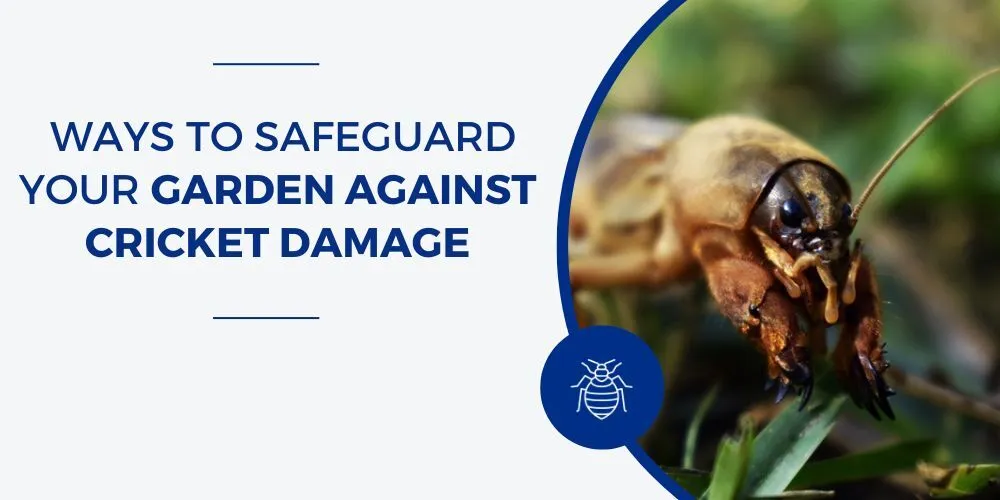Gardens offer a peaceful setting in which to enjoy natural beauty and relax; however, the presence of crickets can quickly disrupt this peace. Cricket infestations in gardens can be a nuisance, causing damage to garden plants, vegetables, even structures. Despite their innocent chirping, crickets pose a major threat to garden plants, often eating leaves and causing damage. This is why it is essential to maintain the attractiveness of your garden and keep it safe from cricket infestation.
In this blog, we'll discuss how to prevent cricket damage in your garden using effective strategies and how DIY pest control products can help you get rid of crickets and create a beautiful garden that you can enjoy, irrespective of the season.
Understanding Crickets
Crickets are members of the Orthoptera family, meaning they are straight-winged insects closely related to insects such as grasshoppers. Although more than 900 cricket species exist, most look quite similar. The species usually share common features such as a cylinder-shaped body, six legs and two long antennae.
Like grasshoppers, crickets have long hind legs that allow them to jump up to 30 inches. They can also vary in size, ranging from 1/12 inch to 2 inches in length. Some species of crickets even have wings, enabling them to fly.
Having crickets in your spring garden can harm your plants as they feed on the plant roots and disrupt the soil. Also, if crickets get inside your house, they can feed on fabrics such as cotton, silk, wool, etc. This can become a cause of frustration for homeowners.
Life Cycle of Crickets
The cricket life cycle has three main stages: egg, nymph and adult. Female crickets usually lay their eggs in soil or plant material. The eggs hatch after about two weeks. The babies look like small, wingless adult crickets.
Over the next several weeks, the nymphs go through the molt several times. As they grow, they shed their exoskeleton. With each molt, they develop wings and become more like adult crickets. The entire cycle usually takes 2 to 3 months, depending on the environment. Once adult, these crickets can live for several weeks.
Types of crickets
The House Cricket
House crickets are small, brown insects known for their chirping sounds. They are commonly found indoors but can also invade gardens, damaging plants. To protect your garden, maintain cleanliness, seal cracks and use natural repellents like neem oil to deter these pests.
Tropical House Cricket
Tropical house crickets grow large and thrive in warm climates. They can be destructive to garden plants by eating leaves and stems. You can protect your garden by using barriers, such as fine mesh netting, removing debris where they hide and introducing natural predators, such as birds, to control their population.
The Field Cricket
Field crickets are usually black and can cause significant damage to garden plants, especially young plants. They feed on a variety of plant materials, including roots and stems. When temperatures get too hot or too cold, field crickets seek relief inside buildings and homes. They are often found in areas of homes where moisture accumulates, including basements and bathrooms. Outside, they like to hide in flower beds and tall grass. Field crickets can be seen throughout the United States.
To prevent cricket damage, inspect your garden often and use an organic pesticide. This will also encourage bugs to eat crickets, keeping their population at a manageable level.
Signs of cricket damage
Crickets are often larger than most household pests and insects, so they are easy to notice when they reside in your home. If you hear a loud chirping noise at night, it's needless to say, you have crickets.
Chewed Leaves
Crickets often chew on leaves, creating jagged edges and small bite marks. This damage can weaken plants, reducing their ability to photosynthesize. Monitoring your garden regularly for such signs can help in early detection and control, ensuring your plants remain healthy and strong.
Holes in Plants.
Crickets can create holes in plant stems, flowers and fruits, causing significant damage. These holes provide entry points for diseases and pests, further harming your plants. Regular inspection and prompt action can prevent extensive damage and maintain the health of your garden.
Soil Disruption
Crickets burrow into the soil, disrupt root systems and affect plant stability. This soil disruption can lead to poor plant growth and reduced nutrient uptake. Ensuring your garden soil is well-maintained and monitoring for burrow signs can help mitigate cricket damage and support plant health.
Cricket Prevention Strategies:
Preventing a cricket infestation is much easier than doing damage control once an infestation has already taken place. These tips for safeguarding your home from a future infestation are being followed.
- Repel crickets with marigold flowers, as their scent keeps these insects away.
- Place physical barriers around plants to prevent crickets from reaching them.
- Use garden netting or netting to prevent crickets from reaching your plants.
- Protect your crops by covering them with lightweight row covers.
- Spray essential oils, such as peppermint or lavender, to repel crickets.
- Keep lawns and patios neat and free from debris.
- Repair any holes and cracks in your home's foundation or exterior walls.
- Vacuum carpets, curtains and furniture to get rid of cricket eggs.
Tips for Maintaining a Cricket-Proof Garden
You need to ensure that your home does not have warm and moist spots where crickets can find comfort. Also, add ventilation to the attic, basement and crawl spaces to reduce humidity. DIY pest control products and methods should be utilized to manage cricket infestations.
Remove standing water
Crickets thrive in moist environments, so it's important to remove standing water from your garden. Check and eliminate water accumulation in pots, trays, and low areas regularly.
Keeping your garden dry reduces cricket habitat, making it less attractive to these pests.
Trim Overgrown Vegetation
Overgrown vegetation provides hiding places for crickets. Mow your plants, bushes and grass to reduce these problems. Keeping your garden well-maintained helps prevent crickets and promotes plant health. This simple practice effectively removes crickets by disrupting their habitat.
Inspect and Repair Garden Fences
Crickets can easily enter your garden through gaps in the fence. To prevent their entry, regularly inspect and repair any damage to your garden fence. A well-maintained fence is a barrier, keeping out crickets and protecting your plants from damage.
Conclusion
Effective cricket control is necessary for maintaining a healthy and vibrant lawn and garden. Using DIY products, organic methods, or repelling plants is a cricket-killer approach that can be tailored to different needs and preferences.
If you seek expert advice and a wide range of effective DIY solutions, Bug & Weed Mart is your go-to resource. With years of experience and a commitment to customer satisfaction, we provide the tools and knowledge you need to tackle cricket issues head-on. Visit Bug & Weed Mart today and take the first step towards a cricket-free outdoor space.

